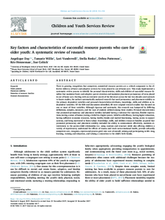Displaying 1451 - 1460 of 2214
This article describes the history and philosophy of foster care in Egypt.
Working collaboratively with two state associations and their member (nonprofit) agencies providing out-of-home care to children and youth, University researchers conducted a multi-site project to examine whether there were any differences in individual child-level outcomes between children placed in residential group care and those placed in foster.
This study implemented a systematic review process to identify the personal characteristics, skills and abilities of successful resource families that maximize foster and adoptive parent retention and maximize placement permanency of teens placed in out of home care.
This study tested relations among maltreatment history, coping behavior, and substance use behavior in youth residing in foster care.
This study aimed at investigating prevalence and precursors of breakdowns in long‐term foster care, the duration of placement before breakdown, and the association of child and placement characteristics with breakdown.
This systematic review examines the comparative effectiveness of foster and kinship care interventions.
This phenomenological study explored the “lived” experience of OoHC from the perspective of 4 adult care leavers reflecting on their childhood.
This systematic review examines the comparative effectiveness of foster and kinship care interventions for trauma.
The purpose of this study is (1) to examine trends in placement use and placement stability since the reform and (2) to document the current frequency of each type of placement setting, the cumulative time in care before the exit to permanency, and the sustainability of the permanency outcome.
The goal of this three-wave longitudinal study was to analyze foster parent stress and foster children’s internalizing and externalizing behaviors in a transactional framework.

